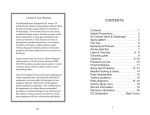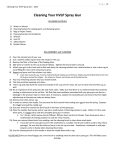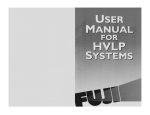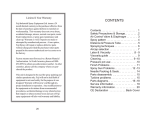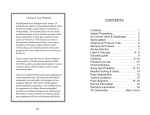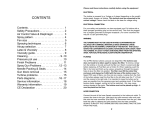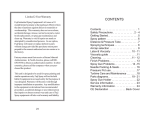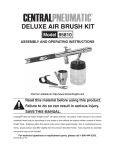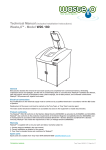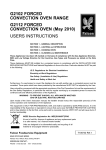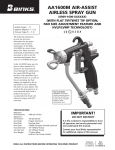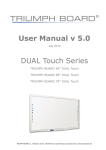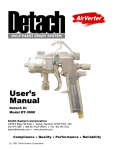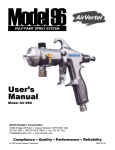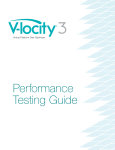Download to the Fuji User Manual pdf file for the T
Transcript
Limited 2 Year Warranty Fuji Industrial Spray Equipment Ltd. issues a 24 month limited warranty to the purchaser effective from the date of purchase against defects in materials or workmanship. This warranty does not cover abuse, accidental damage, misuse, normal wear parts, motor brush replacement, or spray gun maintenance and clean-up. Warranty is void if repairs are made or attempted by unauthorized persons. At our option, Fuji Spray will repair or replace defective parts without charge provided the purchaser return parts prepaid to the nearest authorized service center or to the factory. Factory returns must first receive a Return Material Authorization. In North America, please call 800650-0930 to obtain an authorization number. In other countries, please call the company where you purchased the product. This unit is designed to be used for spray painting and similar operations only. Fuji will not be held liable if equipment is not used solely for the purpose it was designed. Warranty will become void through improper installation or operation. Any modifications to the equipment or deviations from recommended procedures, accidental damage or any related action that impairs or abuses normal wear and care of Fuji spray equipment will also void warranty and liability. 20 CONTENTS Contents . . . . . . . . . . . . . . . . . . . . . . . . . 1 Safety Precautions . . . . . . . . . . . . . . . . 2 Getting Started. . . . . . . . . . . . . . . . . . . . . 3 Spray Pattern . . . . . . . . . . . . . . . . . . . . . . 4 Spraying Technique . . . . . . . . . . . . . 5 Aircap Selection . . . . . . . . . . . . . . . . . . . 6 Viscosity Guide . . . . . . . . . . . . . . . . . . . . 7 Latex Paint . . . . . . . . . . . . . . . . . . . . . . . . 8 General Cleaning . . . . . . . . . . . . . . . . . . . . 9 Cleaning Fluid Passages . . . . . . . . . . . 10 Turbine Problems . . . . . . . . . . . . . . . . . 10 Finish Problems . . . . . . . . . . . . . . . . . .11 Filter Replacement. . . . . . . . . . . . . . . .11 Spray Gun Problems . . . . . . . . . . . . . 12-14 Needle Packing Nut . . . . . . . . . . . . . . . 14 Parts Diagrams. . . . . . . . . . . . . . . . . 15 -18 Service Information. . . . . . . . . . . . . . . . 19 Warranty Information . . . . . . . . . . . . . . 20 CE Declaration . . . . . . . . . . . Back Cover Please read these instructions carefully before using the equipment For SERVICE & PARTS GROUNDING INSTRUCTIONS This appliance must be grounded. If it should malfunction or break down, grounding provides a path of least resistance for electric current to reduce the risk of electric shock. This appliance is equipped with a cord having an equipment-grounding conductor and grounding plug. The plug must be inserted into an appropriate outlet that is properly installed and grounded in accordance with all local codes and ordinances. WARNING- Improper connection of the equipment-grounding conductor can result in a risk of electric shock. Check with a qualified electrician or service person if you are in doubt as to whether the outlet is properly grounded. Do not modify the plug provided with the appliance. If it will not fit the outlet, have a proper outlet installed by a qualified electrician. This appliance is for use on a nominal 120-volt circuit and has a grounding attachment plug that looks like the plug illustrated. Make sure that the appliance is connected to an outlet having the same configuration as the plug. No adapter should be used with this appliance. USA www.hvlp.net Phone: 800-650-0930 Online: www.hvlp.net Phelps Refinishing Phone: 800-377-5662 Online: www.phelpsrefinishing.net CANADA Fuji Spray Phone: 800-650-0930 Local: 416-650-1430 www.hvlp.ca Phone: 800-650-0930 UNITED KINGDOM Axminster Power Tool Centre. Axminster, Devon, England Phone: 01297 33656 Rutlands Limited. Bakewell, Derbyshire, England Phone: 01629 815518 Please Note* For UK, Australia, Asia etc. your voltage will be 220-240v. Check the label on the base of the turbine to ensure your unit is at the correct voltage for your location. THE TURBINE MUST NOT BE USED IN AN AREA CONTAMINATED BY VOLATILE OR FLAMMABLE MATERIALS SINCE SPARKING CAN BE EXPECTED IN THE NORMAL OPERATION OF THE MOTOR. THIS COULD IGNITE THE CONTAMINANTS CAUSING A DANGEROUS EXPLOSION. KEEP THE TURBINE AT LEAST 20 FEET (6 METERS) AWAY FROM THE SPRAYING AREA. FOR HEALTH REASONS, ALWAYS WEAR A RESPIRATOR. PLEASE CHECK WITH THE LOCAL JURISDICTION. THE SPRAYGUN MUST NEVER BE POINTED AT SOMEONE’S FACE. THE OPERATOR MUST WEAR SHOES AND THE FLOOR MUST NOT BE WET. STORAGE INSTRUCTIONS Always store the unit inside in a dry location. Store off the floor if in a basement setting. 2 AUSTRALIA & NZ Spraychief Industries. Campbellfield, Victoria 3061 Phone: 3-9357-8788 PUERTO RICO Eagle Tools Mfg. Corp San Lorenzo, Puerto Rico, 00754 Phone: 787-736-0444 Fra-Marson Warehouse Distributors. San Juan PR, 00926 Phone: 787-761-4810 CHINA, TAIWAN, SINGAPORE, MACAU, HONG KONG Zhuhai Europe & Asia Auto Tech. Zhuhai City, China Phone: 0756-2127555 Fax: 0756-2123769 Copyright © 2013 Fuji Spray® Toronto. Canada 19 GUN HOLDER & FILLING STATION GETTING STARTED NOTE: Throughout this Manual we have used the generic word ‘Paint’ to describe all and any coatings. Please substitute the word ‘Paint’ for whatever finish or coating you are spraying. Your Fuji Spray Gun has been adjusted at the factory and is ready for spraying. To clean out any impurities that may have accumulated during assembly or shipping, we recommend spraying a small quantity of clean paint thinner through the gun. Before tackling any serious spraying, experiment with the Gun on a scrap piece of wood until you become familiar with all the controls. AIR CONTROL VALVE The Air Control Valve 2032 is located on the Hose next to the brass Quick-Connect. It provides you with a means of controlling the air flow through the Gun. It offers you fingertip control when you need it to reduce bounceback and overspray. There is one thing to remember about the Air Control Valve - it is the ‘last in the chain’ of operations after... 1) Thinning the paint 2) Adjusting the shape and size of the spray pattern 3) Adjusting the flow of paint through the Gun. GUN HOLDER INSTALLATION The 2 holes on the top of the Holder require the 2 Machine Screws and Washers. These Screws fit into Threaded Inserts in the Metal Case. Do not over tighten - snug is fine. The single Silver-Colored Screw must be installed to the single hole on the side of the Gun Holder. Once again, please do not over tighten this screw - snug is fine. After performing these operations, you should spray a few passes onto a scrap piece of plywood or cardboard. This will allow you to determine if the paint levels nicely. Once the Gun is producing a perfect finish with full air, you may then experiment with turning the air down until bounceback is reduced to a mininum. However, if orange-peel results, you have no option but to turn the air up again a slight amount. PLASTIC DIAPHRAGM If you do not intend on using the Gun Holder you may insert the appropriate screws (as mentioned above) to block the holes. GUN HOLDER USE Place the Hose Connector 5229 (base of the Gun Handle) over the shaft of the Gun Holder shown in above illustration. Please ensure it is fully set down to the base of the Shaft. The Spray Gun will now sit stationary. The Gun can be left on the Holder for any length of time. It is a convenient resting place between spraying and ideal for filling the Gravity Cup. 18 The 1 Quart pressurized Cup has a plastic Diaphragm 2038 (not found in the Gravity Spray Gun). This Diaphragm prevents paint from entering the Pressure Tube 2024. The small air hole in the Diaphragm should not be placed directly below the air hole in the Nipple. Position the Diaphragm hole to the rear of the Cup. The Spray Gun can be turned to different angles when spraying but never turned more than horizontal. HOSE CONNECTION Connect the Hex Nut at the end of the Hose (Female Connector) to the Turbine Air Outlet. Tighten this Nut lightly. Overturning could cause the internal Manifold to rotate and break the internal Seal to the Motor. A Quick Connect Coupler is available as an accessory for the connection to the turbine. 3 CHANGING THE SHAPE OF THE FAN A) Loosen the Collar 5201. Turn the Air Cap 5202 to the horizontal position then re-tighten the Collar to lock it into place. This setting produces a vertical spray pattern. This pattern is used more than any other by experienced spray painters. B) Setting the Air Cap in a vertical position produces a horizontal spray pattern. To lock it in position, tighten the Collar. The horizontal fan pattern is the most useful for painting vertically such as a doorframe. CHANGING THE SIZE OF THE FAN To produce a smaller fan pattern, turn the Pattern Control Knob 5225 counter-clockwise. Because the spray pattern size is now much smaller, you must turn down the amount of paint spraying through the Nozzle at the Fluid Adjusting Knob 5221 (rear of gun). If you do not do this, you will get runs. To set the fluid output, simply turn the Fluid Adjusting Knob counterclockwise for more ‘paint’ and clockwise for less. Once you set the fluid to your liking, you can leave it in this position - unless of course, you change the size of the fan pattern. For the very smallest pattern (less than about 1 1/2”), you must move the Gun closer to the workpiece - but don’t forget to reduce the amount of paint at the Fluid Adjusting Knob. 4 17 FUJI T-70 & T-75G SPRAY GUN ACTUAL SPRAYING TECHNIQUES. The Spray Gun should be held perpendicular to the surface at all times. HOLD THE GUN NO MORE THAN 8” (20cm) AWAY FROM THE SURFACE TO BE PAINTED. CORRECT METHOD Start off the piece. Pull the Trigger and move the Spray Gun in the direction you want to spray. Continue off the edge of the piece on the other end before releasing the Trigger. Between each successive pass, overlap by about a half. INCORRECT METHOD Never, for any reason, point the Spray Gun directly at the face, or head of a person. 16 5 AIR CAP SET SELECTION Six additional size Setups are available as accessories. Size No.3 (1.3mm) is standard with all Fuji T-Spray Guns. No. 2, 3 or No. 4 can be used for any type of fine-finishing application. The larger sizes such as No. 4 allow for more fluid output - desirable with fast drying lacquers. AIR CAP SET - Part 5100 Series If you do not intend on spraying walls & ceilings the only additional Setups you need would be the No. 2 and No. 4. No. 1 (Part 5100-1) .8mm (.031") SUPER-FINE OUTPUT SHADING, STAINS. No. 2 (Part 5100-2) 1mm (.039") FINE OUTPUT SHADING, STAINS, WATERBORNE COATINGS. No. 3 (Part 5100-3) 1.3mm (.051") FINE - MEDIUM OUTPUT - STANDARD WATER-BASED LACQUERS, ACRYLICS, POLYURETHANE, STAINS. No. 4 (Part 5100-4) 1.5mm (.059") MEDIUM OUTPUT Similar to No. 3 but more coverage. Best for AUTOMOTIVE ENAMELS, LACQUER and LATEX. Also VARNISHES, PRIMERS, OIL-BASED PAINTS. No. 5 (Part 5100-5) 1.8mm (.070") HIGH OUTPUT Larger surfaces, thick layers, spotted effects. SEALERS, VARNISH, POLYURETHANE, OIL BASED PAINTS, ENAMELS, EPOXIES, ETC. No. 6 (Part 5100-6) 2mm (.078") EXTRA HIGH OUTPUT Very heavy flows, fast coverage. STONE FINISH PAINTS, TEXTURE COATING, INDUSTRIAL PRIMERS, MULTI-FLECK PAINTS, LATEX on walls, ceilings ETC. No. 7 (Part 5100-7) 2.5mm (.098") MAXIMUM HIGH OUTPUT Heavy flows, faster coverage. LATEX HOUSE PAINT on walls etc. 6 15 LEAKAGE FROM THE NOZZLE VISCOSITY GUIDE This occurs when the Needle Packing Nut 5210 is too tight compressing the Needle Packing 5209 too tightly around the Needle. A Viscosity Cup is included with your Fuji System. Half fill the cup with water. Attach the Gun to the Hose and turn on the Turbine blower to pressurize the Cup. Pull the Trigger and release. Check the Nozzle for water spurting out. Use the supplied wrench to GENTLY loosen the Nut (1 or 2 degrees only at a time). This is a very sensitive adjustment. Again pull the Trigger and release. Wipe away the water in between adjustments. Repeat until no water is seen at the Nozzle Hole. To test the viscosity of the paint material, fill the Viscosity Cup to the brim and time how long it takes for the liquid to empty out through the hole. We recommend you experiment to find the ideal viscosity for your application and record the information for the next time. Always check with the manufacturer of the coating for assistance in thinning for spraying. If their product is only designed to be brushed, they may not be too helpful. But remember that any type of coating can be sprayed if it is thinned correctly (with the appropriate solvent) and you have installed the ideal aircap set. LEAKAGE FROM THE NEEDLE PACKING NUT This occurs when the Needle Packing Nut is too loose. The chart below illustrates how many SECONDS it should take for the material to flow out of the viscosity cup. This is only an approximate guide. Half fill the cup with water. Attach the Gun to the Hose and turn on the Turbine blower to pressurize the Cup. Use the supplied wrench to GENTLY tighten the Needle Packing Nut 1 or 2 degrees only. This is a very sensitive adjustment. Wipe away the water in between adjustments. Repeat until no water is seen where the Needle passes through the Needle Packing Nut 5210. Auto Lacquers Enamels Latex Oil-based 18 - 20 18 - 20 20 - 25 20 - 30 20 - 25 Primers Sanding Sealers Stains Creosote Polyurethanes 30 - 40 20 - 22 Undiluted Undiluted 20 - 25 We suggest thinning around 25% to begin with but this may contravene the air quality control laws for your location. The Solvent used for thinning is usually the solvent mentioned on the can (instructions for ‘cleaning the brushes’). However, please check with the coatings manufacturer. The aim is to thin as little as possible. It is a good idea to apply Light Machine Oil or Vaseline to the Needle Shaft where it passes through the Needle Packing Nut and work it in and out by pulling the Trigger back and forth. This will lubricate the Needle Packing 5209. 14 HVLP spraying is more friendly to the environment than most methods of spraying. It reduces appreciably the amount of unnecessary misting and fogging (overspray) associated with high-pressure spraying. Spraying with Nitrocellulose lacquer can be hazardous. The lacquer, fumes and overspray are toxic, flammable and explosive. If spraying must be done inside an enclosed area, ventilate well. Spray close to an open window or door and situate a fan to draw out the fumes (an explosion-proof motor and explosion-proof lighting will be necessary). Please check with the local Authority having jurisdiction on this matter. 7 A WORD ABOUT LATEX THE TRIGGER IS SLUGGISH Although Latex Paint was never originally intended to be sprayed, a professional finish can be achieved by following a few simple rules. (Please do not confuse Latex with the newer water-based coatings). For work such as cabinetry or trim, our equipment can be used successfully with Latex Paint. The Latex will have to be thinned with WATER - approximately 10-30% depending on the brand of paint. And to improve the finish even more, you can use an additive that will slow down the drying process so that the paint levels out nicely. One product available is Floetrol from the Flood Company in Ohio. In the USA Call 1-800-321-3444 for your nearest supplier. (In the U.K. 0845-0618899). • • The Needle Packing is too tight - see ADJUSTING THE NEEDLE PACKING. Page 14 Bent Needle POOR SPRAY PATTERN • • • • Damaged Needle or Nozzle Nozzle is clogged Air holes in Air Cap clogged Gun too far from surface (max. 8” - 20cm) PAINT AT THE AIR NOZZLE HOLES The ideal Aircap size Setup is either the No. 4 or No. 5 for household trim, louver doors etc. The Latex paint should be ‘finish-quality’ and not a cheaper grade. • • When spraying Latex, please adjust the Fluid Knob 5221 to limit the paint to a finer spray. This will increase the ratio of air to paint and result in better atomization and a beautiful finish. (Factually speaking, it doesn’t increase the ratio of air to paint but does the opposite - it allows the air atomizing power to work on less paint thereby improving the quality of atomization). Also, it is usually helpful to remove the Air Control Valve so that more air passes through the Spray Gun. Finally, adjust the pattern to a maximum size of 8” - 9” (20cm) - smaller is ok. Apply a wet coating (wet like a lake). Although it is possible to use our equipment for house painting (walls), and many end users do, we feel that an airless gun or power roller is better suited for that kind of job. However, if you decide to do this kind of work, you will need the #6 or #7 Aircap set. Remember, when you buy a can of paint, lacquer, polyurethane, varnish etc. over the counter, it will most likely be formulated for brushing. That means, it will be too viscous (thick) and will require thinning to spray successfully. This is true even when spraying is mentioned on the label of the can. Check with the manufacturer of the coating to obtain advice on thinning their product. Unfortunately, sometimes you may encounter Technical Sales Personnel that have very little experience or knowledge about HVLP Turbine spraying. The Fluid Nozzle is loose and material is leaking around it tighten with the supplied Wrench Paint is entering the gun via the Pressure Tube and being blown through the Barrel to the Aircap GUN SPRAYS IN A PULSATING MANNER • • • • • The Needle Packing has worn a little or is loose. Tighten The Cup is almost empty The Cup Lid is not tight - air is escaping The clear Plastic Pressure Tube is leaking air. Replace The Pressure Tube and/or Nipple is clogged. Clear or replace EXCESSIVE OVERSPRAY • • • • • • The spray pattern size is too large for the item being sprayed The Gun is being held too far away - should be 8” max. (20cm) Trigger on and off as you pass over the edges of the item The ‘paint’ is too thin - try thinning less Reduce the air by turning the Air Control Valve to the point where overspray is minimized but the finish still looks good For ideal and comfortable spraying conditions, you should install an extraction fan.* If you are spraying a flammable, combustible product such as nitrocellulose lacquer, you must install an explosion-proof fan (and explosion-proof lighting and switches) * Please check with the local jurisdiction on this matter. 8 13 SPRAYGUN PROBLEMS GENERAL CLEANING NO PAINT (OR VERY LITTLE PAINT) To clean the Gun after each use, empty all paint from the Cup. Use a solvent-soaked rag to clean the residue in the Cup. Then, spray some clean solvent through the Gun into a clean rag (to avoid filling the room with unnecessary spray) or a bucket. Repeat until the inside of the fluid passages in the Gun, Metal Fluid Tube etc. are clean. Use the wet rag to wipe off the Air Cap and tip of the Fluid Nozzle. The Air Cap can be soaked in thinner. The air passing through the Pressure Tube 2024 to pressurize the Cup is blocked. This means that either the Tube itself, the Check Valve, or one of the two Nipples are blocked. A pipe cleaner can be used for cleaning the hole in the Nipple. • • • • • Pressurizing Tube and/or Nipples are blocked - COMMON The Cup is not tightened down sufficiently or the Cup Lid Gasket is worn and leaking air The Cup is empty The metal Fluid Tube is blocked with paint - RARE The Fluid Coupler is blocked with paint - RARE UNEVEN SPRAY PATTERN One of the holes in the Air Cap may be blocked. Or, the paint could be dirty and is partially blocking the Fluid Nozzle. Remove the Air Cap and clean by soaking in solvent and using the soft Bristle Brush or a rag. NEVER use metal objects to clean holes in the Air Cap. LEAKAGE If paint material comes out of the Fluid Nozzle without pulling the Trigger... • • • • • • The Needle is not seating in the Fluid Nozzle properly The Needle Packing may be too tight preventing the Needle from moving - See Page 13 Packing Adjustment Foreign matter trapped between Needle and Fluid Nozzle The Needle or Fluid Nozzle could be damaged or worn Loose Fluid Nozzle Wrong Fluid Nozzle size installed CUP LEAKS • • • • • Oil above and below the Lever to smooth the Lever action Change Gasket/Diaphragm Leak around Nipple - use Loctite to seal Leak around Side Pins - use Loctite to seal Leak through Lid - remove Nut under Lid - use Loctite 12 If this type of cleaning is done while the paint is still wet in the Gun, it should be all that is necessary to keep the Gun clean enough for next time. Do not leave liquids in the Cup overnight or for long periods. Do not restrict the Fluid Nozzle when cleaning (by putting your finger over the Nozzle Orifice) - this will drive thinned paint up the pressure tube and into the spraygun which is undesirable. PLEASE DO NOT USE A WIRE BRUSH OR ANYTHING METAL TO CLEAN THE GUN OR CUP AS THIS WILL CAUSE DAMAGE. DO NOT disassemble the Cup Assembly - Threads in your cup have been sealed at the factory to prevent leakage under pressure. The standard 1 quart (1000cc) Cup can be used with most coatings (including water-based). Also available as an accessory is our 2041T Teflon-coated Cup. Four sizes of Gravity Cups are also available. CAUTION: Never soak the complete Spray Gun in solvent as this removes the grease from the parts and distributes thinned paints throughout the air passages. It could also damage internal parts such as the Spindle Valve or Valve Seals. It may sometimes be necessary to soak the Air Cap 5202 and Nozzle 5203. You may soak only the metal parts in solvent and clean with the soft bristle Cleaning Brush 9045. To reassemble, first oil or grease all moving and threaded parts. CAUTION: Do not store the Gun with the Cup clamped down hard as this will cause the Gasket to flatten out. Do not lay the Gun down on its side with liquid material in it. 9 CLEANING FLUID PASSAGES FINISH PROBLEMS To clean, flush solvent through the Spray Gun while the paint is still wet inside the Gun. If this type of quick cleaning is performed frequently, the Spray Gun will function well for many years. 99% of problems with a Spray Gun stem from clogs in the fluid passages and (perhaps more important), the Pressure Tube air passages. Please see Page 12... No Paint (or very little paint). ORANGE PEEL - If the finish is rough and resembles orange peel then the material is too thick. (Or perhaps you have the Air Control Valve turned down - please check that it is fully open). The ‘paint’ will not atomize properly and the surface will be spotty. To remedy this, add more thinner (or appropriate solvent). For fast drying products such as lacquers, you may also want to add a lacquer retarder. This will slow the drying time allowing the material to flow out and level nicely. CLEANING BEHIND THE FLUID NOZZLE Remove the Collar 5201 and Aircap 5202. Using the supplied Wrench, remove the Fluid Nozzle 5203. Once the Fluid Nozzle is removed please be careful that the Air Diffuser 5204 does not fall out of the Gun. Use the Cleaning Brush and appropriate Solvent to clean behind the Fluid Nozzle. The Air Cap, Fluid Nozzle, Needle may be soaked in solvent. To remove the Needle, remove the Fluid Knob 5221, Spring 5220 from the rear of the gun. The Needle can then be soaked and later wiped clean. When reinstalling the Air Diffuser, note that there is a Locating Pin on the back side. This pin must be located into the matching hole in the Air Divider 5207. PLEASE DO NOT SOAK THE WHOLE GUN IN ANY LIQUID - THIS IS NEVER NECESSARY OR ADVISABLE. CLOGGED GUN - THE FLUID COUPLER If the Fluid Coupler 5208 (T-70) or 5211 (T-75G) is clogged with dried paint it must be cleaned while in place in the Gun. The Fluid Coupler should not be removed. Remove the Cup Assembly by loosening the Nut. Use the supplied Cleaning Brush to unclog the inside of the Fluid Coupler using Solvent. Replace the Cup. Before tightening, position the Cup to the preferred position and tighten the Nut. TURBINE PROBLEMS NO POWER - Check your Power Outlet. Also, try re-setting the Breaker on the back of the Turbine by pressing it once. PLEASE DO NOT TRY TO SERVICE THE TURBINE YOURSELF. CONTACT US FOR TECHNICAL ASSISTANCE. 10 Retarders are available for other coatings too, such as Penetrol for Oilbased paints or Floetrol for Latex house paints. These products go under different names such as Flow-Out Additives etc. Please check with the coatings manufacturer. NOTE: With the newer water-based materials ‘orange peel’ is usually a result of spraying on too thick a film. Try spraying an extremely THIN FILM, but still WET coat. With most other coatings, orange peel is caused by material being too thick or not enough atomizing power. This is why we suggest leaving the air control valve fully open when experimenting with a new coating material, otherwise it will cause confusion. If the the Air Control Valve is fully open (or perhaps removed for Latex spraying) then orange peel can only be one cause the material is too thick and must be thinned. GRITTY FINISH - If the material is too thin, it is likely to run or be over-atomized, producing a rough gritty finish. Try thinning the product less and spraying a wetter coat. FILTER(S) The Fuji HVLP Turbines have either 1 or 2 Filters. To remove, simply pull the Filters out from the bottom of the Filter Enclosures. Wash in solvent and dry before replacing. All Fuji Filters are a friction fit. The Filter must fill the entire Filter Enclosure. If 2 filters, then one of the Filters is fine and one coarse the fine Filter is installed to the left side and the coarse to the right side (as seen looking at the front of the Turbine where the Hose is connected). Cleaning your filters regularly is essential to maintaining your Turbine. It is always a good idea to have a spare pair of filters on hand. 11











